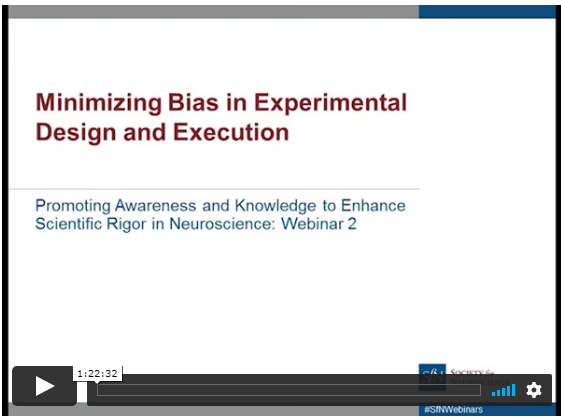Follow this module to learn about the various types of validity in experimental research
After completing it, you should be able to:
- Explain what bias is
- Explain how bias differs from variability and confounding
- Describe measures to reduce bias and implement them in an experimental protocol
- Explain what external validity is
Core materials
Material 1 – Bias is Bad
Study this material to learn about:
- What the concept of bias is and what it’s consequences are
- The difference between random error and systematic error
Type: Videoscribe
Duration: 4 minutes
Created by: Sketchy EBM
Material 2 – Internal valdity of preclinical studies
Study this material to learn about:
- Five common types of bias that can occur over the course of an experiment
- Blinding and randomization as key measures to reduce the risk of selection bias, performance bias and detection bias
- Preregistration as an important measure to reduce the risk of bias due to selective outcome reporting
Type: Weblecture
Duration: 20 minutes
Speaker: Dr. Kim Wever
Material 3 – Introduction to risk of bias concept in critical appraisal of studies
Study this material to learn about:
- The different types of bias that can occur during different stages of a study
- Measures you can take to reduce the risk of these biases
- Different risk of bias assessment tools and how to use them
Type: Weblecture
Duration: 1 hour
Created by: Thomas Hartung, Johns Hopkins University
Material 4 – Recruitment (external validity)
Study this material to learn about:
- What external validity is and why it is important
Type: Videoscribe
Duration: 5 minutes
Created by: Healthcare Triage
Material 5 – Designing animal studies for better human translation
Study this material to learn about:
- a first impression of possible causes for the limited translation of results from preclinical studies to to patients
- Examples of bias and external validity issues
Type: Interview
Speaker: Malcolm Macleod, University of Edinburgh
Duration: 4 minutes
Created by: American Physiology Society (part of the 2015 Reproducibility in Research Symposium)
Material 6 – Animal models for human diseases – How can we improve translation of effects to humans?
Study this material to learn about:
- Possible causes for translational faillure, illustrated by examples from neurosciences and other fields of research
- Several types of bias affecting preclinical research
- Effects of external validity on translation
Type: Webinar
Speaker: Malcolm Macleod, University of Edinburgh
Duration: 30 minutes
Created by: American Physiology Society (part of the 2015 Reproducibility in Research Symposium)
Bonus materials
Bonus 1 – Lost to follow-up (full version)
Study this material to learn about:
- What attrition bias is and how it can affect study results
- How to properly report drop-outs in publications
Type: Videoscribe
Duration: 5 minutes
Created by: Sketchy EBM
Bonus 2 – Minimizing bias in experimental design and execution
Study this material to learn about:
- Different sources of bias and how they can influence experimental design, data collection, and reporting
- Best practices for minimizing bias in experimental procedures, including: blinding; systematic random sampling; inclusion of positive and negative controls; and methods of quality control for reliability and reproducibility
- How biases can affect rigorous implementation of the scientific method and considerations for unbiased hypothesis testing
Type: webinar
Duration: 80 minutes
Speakers: Dr. John Morrison, Dr. Christophe Bernard and Dr. Patrick Hof
Created by: Society for Neuroscience, featured in the Promoting Awareness and Knowledge to Enhance Scientific Rigor in Neuroscience webinar series
Bonus 3 – Blinding
Study this material to learn about:
- What blinding is
- How blinding can prevent some types of bias
Type: Videoscribe
Duration: 5 minutes
Created by: Healthcare Triage
Bonus 4 – Observer bias
Study this material to learn about:
- What observer bias is and how it can affect a study’s outcome
- Which measure to take to minimize observer bias
Type: Videoscribe
Duration: 5 minutes
Created by: Healthcare Triage
Bonus 5 – Randomisation
Study this material to learn about:
- What randomisation is
- How randomisation can prevent some types of bias
Type: Videoscribe
Duration: 5 minutes
Created by: Healthcare Triage
Bonus 6 – Confounding
Study this material to learn about:
- An example of confounding within an experiment
- Why random allocation, and not breaking randomization are important
Type: Videoscribe
Duration: 5 minutes
Created by: Stats in the Lab
Bonus 7 – Randomisation
Study this material to learn about:
- The importance of randomization
Type: Videoscribe
Duration: 5 minutes
Created by: Stats in the Lab
Bonus 8 – Batch effects
Study this material to learn about:
- Define batch effects
- Explain how batch effects can confound experimental conditions with factors not of interest
- Give examples of factors that could cause batch effects
- Identify ways to avoid batch effects
Type: Videoscribe
Duration: 5 minutes
Created by: Stats in the Lab
Additional resources
- Key publication: SYRCLE’s risk of bias tool for animal studies
- Tool: The NC3Rs Experimental Design Assistant (EDA) – a free online tool to guide researchers through the design of their in vivo animal experiments
Was anything missing? Would you like to suggest another training material or resource? Please click here for our suggestion form.


